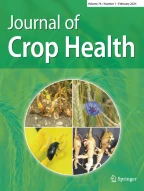Zusammenfassung
Die Dürrfleckenkrankheit ist weltweit eine der wichtigsten Pilzkrankheiten an Kartoffeln und Nachtschattengewächsen. Aufgrund zunehmender Schäden stellt die Dürrfleckenkrankheit für den deutschen Kartoffelanbau ein wachsendes Problem dar. Am häufigsten werden zur Bekämpfung der Krankheit protektiv wirkende Fungizide angewendet, die einem Befall der Dürrfleckenkrankheit vorbeugen oder diesen reduzieren. Dabei nehmen die unterschiedlichen Wirkungsweisen der Präparate wesentlich Einfluss auf den Verlauf der Alternaria-Epidemie. Im Verlauf der Vegetationsperiode 2007 und 2008 wurden Feldversuche durchgeführt, anhand derer wirkstoffspezifische Befallsbonituren erhoben wurden. Die hier dargestellten Ergebnisse zeigen, dass die Befallsentwicklung der Dürrfleckenkrankheit in Abhängigkeit des applizierten Wirkstoffs unterschiedlich stark gehemmt wurde. Die Anwendung spezifischer, gegen die Dürrfleckenkrankheit wirksamer Fungizide, resultierte in einer längeren Gesunderhaltung photosynthetisch aktiver Blattfläche. Dadurch konnte die Assimilationsdauer der Kartoffelpflanzen verlängert und als Konsequenz deren Ertrag gesteigert werden. Vor allem Wirkstoffe aus der Gruppe der Strobilurine (Azoxystrobin, Boscalid + Pyraclostrobin) zeigten deutlich bessere Wirkungserfolge in der Bekämpfung der Dürrfleckenkrankheit als Wirkstoffe wie Mancozeb, Chlorthalonil bzw. Fenamidon.
Abstract
Potato early blight caused by Alternaria solani and Alternaria alternata is a major disease of potatoes and other Solanaceae. By now, Alternaria species have established themselves as destructive pathogens. Due to considerable yield losses early blight is getting a serious problem in many German potato growing areas. Up to now, the management of this disease is achieved mainly through protective fungicide applications. By this, fungicides with different mode of actions have a considerable influence on the course of disease progress. For this, field trials were carried out in 2007 and 2008 and the efficacy of various active ingredients was determined. Marked differences were observed in the control of early blight disease due to the effectiveness of applied active ingredients. The application of potent fungicides, which are highly efficient, resulted in prolonged photosynthesis. As a result of this potato yield increased significantly. Our investigation show, that disease control can be better achieved with strobilurines like Azoxystrobin or Boscalid + Pyraclostrobin than with Mancozeb, Chlorthalonil or Fenamidon.



Literatur
Bouwman JJ, Rijkers G (2004) The control of Alternaria solani (early blight) with azoxystrobin in potatoes. In: Westerdijk CE, Schepers HTAM (Hrsg) PPO-special report no. 10, Appl Plant Res BV, Wageningen, S 179–188
Brent KJ, Hollomon D (2007) Fungicide resistance in crop pathogens: how can it be managed? Fungicide Resistance Action Committee, FRAC Monograph no. 1 (second revised edition)
Christ BJ, Maczuga SA (1989) The effect of fungicide schedules and inoculum levels on early blight severity and yield of potato. Plant Dis 73:695–698
Franc GD, Stump WL (2008) Management of potato early blight with foliar fungicide programs. Plant Dis Manag Rep 3:V056
Fry WE (1994) Role of early and late blight suppression in potato pest management. In: Powelson ML (Hrsg) Advances in potato pest biology and management. American Phytopathological Society, St. Paul, S 166–177
Gent DH, Schwartz HF (2003) Validation of potato early blight disease forecast models for Colorado using various sources of meteorological data. Plant Dis 87:78–84
Harrison MD, Livingstone CH, Oshima N (1965) Control of potato early blight in Colorado. I. Fungicidal spray schedules in relation to the epidemiology of the disease. Am Pot J 42:319–327
Hausladen H (2004) Grundlagen für ein Entscheidungskonzept zur Bekämpfung der Kraut- und Knollenfäule an Kartoffeln und seine Einführung in die Praxis, PhytophthoraModell Weihenstephan. Dissertation, Technische Universität München – Weihenstephan
Hausladen H, Bässler E, Asensio N (2004) Early blight of potato in PPO-special report no. 10. In: Westerdijk CE, Schepers HTAM (Hrsg) Appl Plant Res BV, Wageningen, S 173–177
Horsfield A, Wicks T, Davies K, Wilson D, Paton S (2010) Effect of fungicide use strategies on the control of early blight (Alternaria solani) and potato yield. Austral Plant Path 39:368–375
Leiminger JH (2009) Alternaria spp. an Kartoffeln – Empirische Untersuchungen zur Epidemiologie, Schadrelevanz und integrierten Bekämpfungsstrategien. Dissertation, Technische Universität München – Weihenstephan
Lucas JA (2006) Avoiding and managing fungicide resistance. Proceedings of the HGCA R&D conference held at the Brighton Hilton Metropole Hotel, Brighton, UK, 18–21 November 2002, S 941–946
Pasche JS, Wharam CM, Gudmestad NC (2004) Shift in sensitivity of Alternaria solani in responses to QoI fungicides. Plant Dis 88:181–187
Rosenzweig N, Atallah ZK, Stevenson WR (2008a) Evaluation of Q.I fungicide application strategies for managing fungicide resistance and potato early blight epidemics in Wisconsin. Plant Dis 92:561–568. doi:10.1094/PDIS-92-4-0561
Rosenzweig N, Olaya G, Atallah ZK, Cleere S, Stanger C, Stevenson WR (2008b) Monitoring and tracking changes in sensitivity to Azoxystrobin fungicide in Alternaria solani in Wisconsin. Plant Dis 92:555–560. doi:10.1094/PDIS-92-4-0555
Rotem J (1994) The genus Alternaria, biology and pathogenicity. APS Press, St. Paul
Shtienberg D, Fry WE (1990) Field and computer simulation evaluation of spray-scheduling methods for control of early and late blight of potato. Phytopath 80:772–777
Stevenson WR (1993) Management of early blight and late blight. In: Rowe RC (Hrsg) Potato health management. APS Press, St. Paul, S 141–147
Stevenson WR, James RV (2005) Evaluation of fungicides to control early blight of potato – Hancock, 2008. Fungic Nematic Tests 61:V045
Stevenson WR, James RV (2007) Evaluation of fungicides to control early blight of potato – Hancock. Plant Dis Manag Rep 2:V050
Teng PS, Bissonnette HL (1985) Potato yield losses due to early blight in Minnesota fields, 1981 and 1982. Am Pot J 62:619–628
Van Der Waals J, Korsten L, Denner FDN (2003) Early blight in South Africa: Knowledge, attitudes and control practices of potato growers. Pot Res 46:27–37
Viskonti A, Chelkowski J (1992) Alternaria-Biology, plant diseases and metabolites. Elsevier, Amsterdam
Author information
Authors and Affiliations
Corresponding author
Rights and permissions
About this article
Cite this article
Leiminger, J.H., Hausladen, H. Wirkung verschiedener Fungizide auf den Befall der Dürrfleckenkrankheit (Alternaria spp.) sowie auf den Ertrag der Kartoffel. Gesunde Pflanzen 63, 11–18 (2011). https://doi.org/10.1007/s10343-011-0237-y
Received:
Accepted:
Published:
Issue Date:
DOI: https://doi.org/10.1007/s10343-011-0237-y
